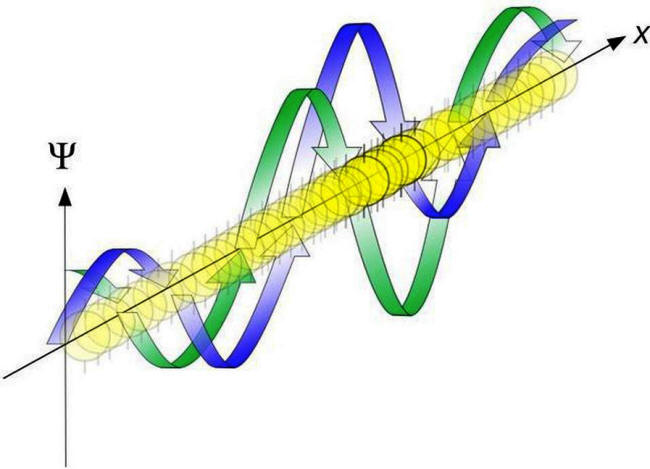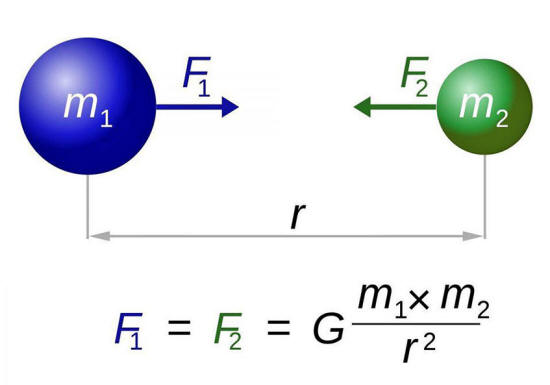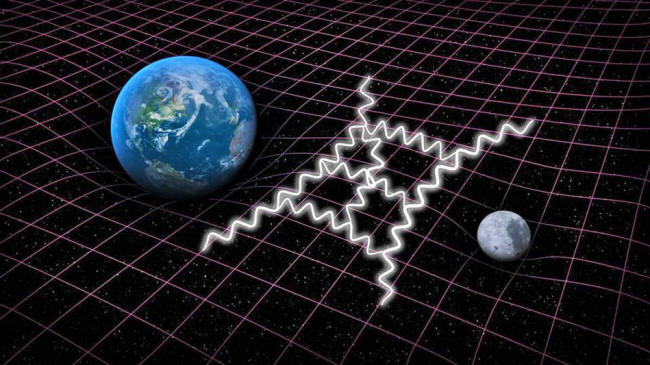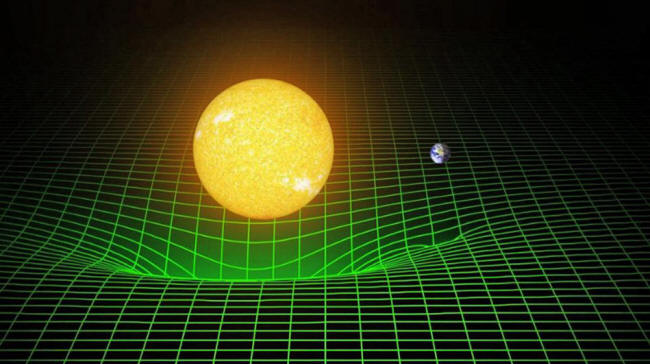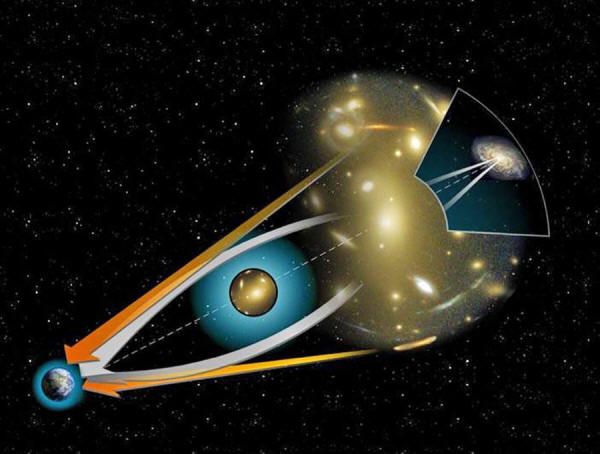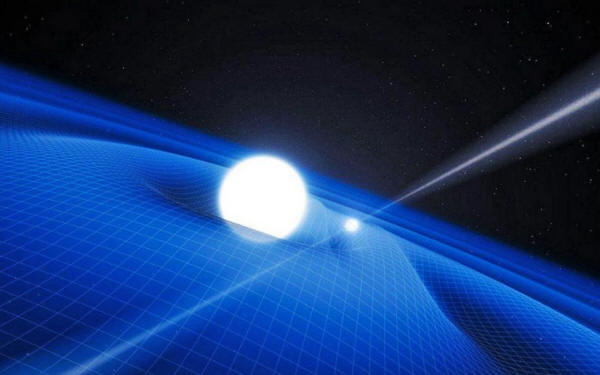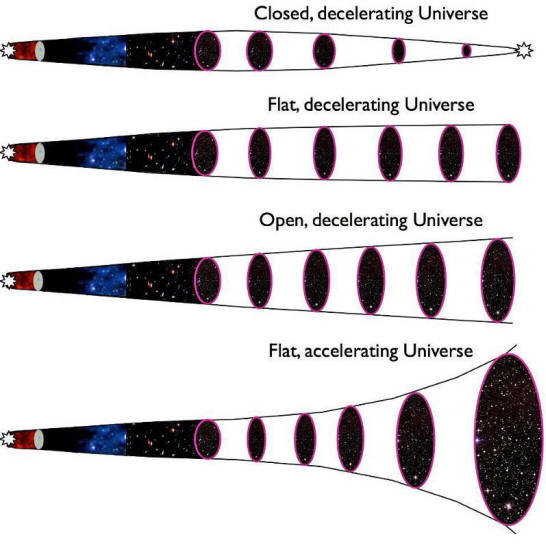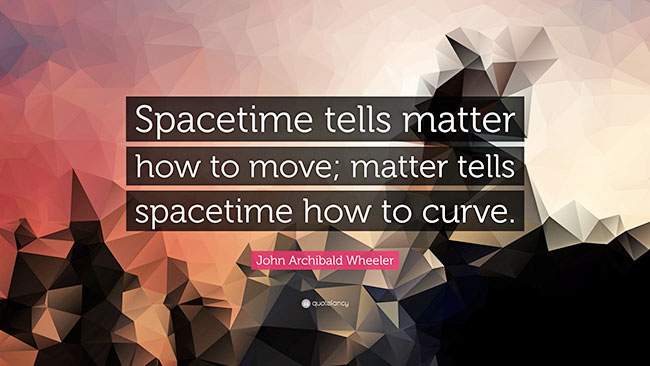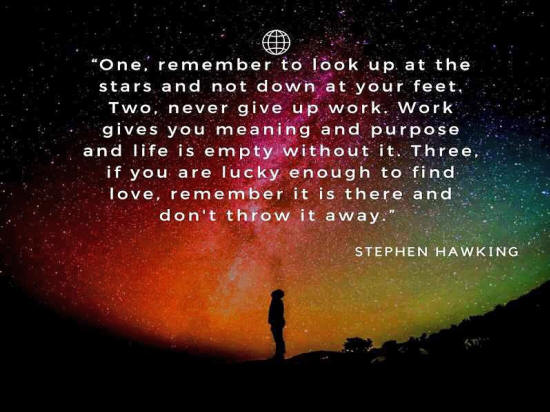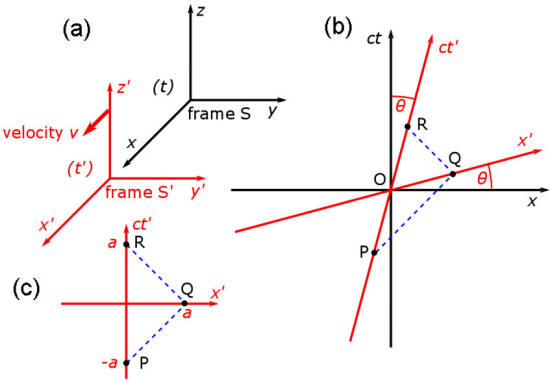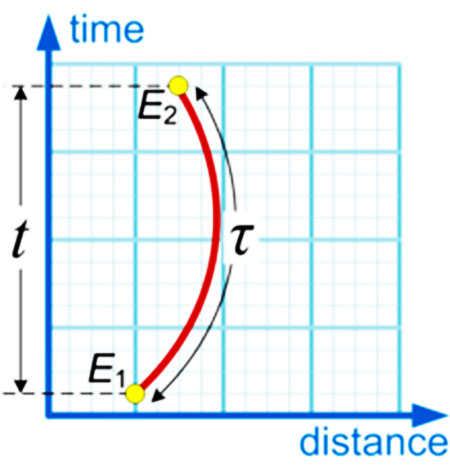|
by Jyotiraditya from Medium Website
November 02, 2018
whether waves, particles or anything in between, have properties that define what they are. But they require a stage on which to interact and play out the Universe's story. Image credit: Wikimedia Commons user Maschen.
But despite being around for over 100 years now, General Relativity2; (GR) - 2;Einstein's greatest achievement2; - 2;is largely mysterious to everyone from the general public to undergraduate and graduate students in physics.
Could you one day write a
story explaining to a lay person what the metric is in GR?
Quantum physics might be relatively
new, having been founded in mostly the 20th century, but
the idea that the Universe was made of indivisible entities that
interacted with each other goes back more than 2000 years, to at
least
Democritus of Abdera.
has been superseded by Einstein's general relativity, but relied on the concept of an instantaneous action (force) at a distance.
Image
credit: Wikimedia commons user Dennis Nilsson.
Space itself was a fixed entity, sort of like a Cartesian grid:
Time always passed at the same rate, and was absolute as well. To any observer, particle, wave or quantum anywhere, they should experience space and time exactly the same as one another.
But by the end of the 19th century, it was clear that Newton's conception was flawed.
Particles that moved close to the speed of light experienced time differently (it dilates) and space differently (it contracts) compared to a particle that was either slow-moving or at rest.
A particle's energy or
momentum was suddenly frame-dependent, meaning that space and time
weren't absolute quantities; the way you experienced the Universe
was dependent on your motion through it.
for observers moving at different relative speeds, but this is due to the constancy of the speed of light. Einstein's law of special relativity governs how these time and distance transformations take place. Image credit: John D. Norton
In 1907, Einstein's former professor, Hermann Minkowski, made a brilliant breakthrough:
In one fell swoop, he had developed the formalism of spacetime.
This provided a stage for particles to move through the Universe (relative to one another) and interact with one another, but it didn't include gravity.
The spacetime he had
developed2; - 2;still today known as Minkowski space2; - 2;describes all
of special relativity, and also provides the backdrop for the vast
majority of the quantum field theory calculations we do.
are normally done in flat space, but general relativity goes beyond that to include curved space. QFT calculations are far more complex there.
Image
credit: SLAC National Accelerator Laboratory.
Spacetime would be simple, uncurved, and would simply provide a stage for matter to move through and interact. The only way you'd ever accelerate would be through an interaction with another particle.
But in our Universe, we
do have the gravitational force, and it was Einstein's principle of
equivalence that told us that so long as you can't see what's
accelerating you, gravitation treats you the same as any other
acceleration.
a ball falling to the floor in an accelerated rocket (left) and on Earth (right) is a demonstration of Einstein's equivalence principle. Image credit: Wikimedia Commons user Markus Poessel,
retouched by Pbroks13.
The major difference between special relativity's Minkowski space and the curved space that appears in general relativity is the mathematical formalism known as the Metric Tensor, sometimes called Einstein's Metric Tensor or the Riemann Metric.
Bernhard Riemann was a pure mathematician in the 19th century (and a former student of Gauss, perhaps the greatest mathematician of them all), and he gave a formalism for how any fields, lines, arcs, distances, etc., can exist and be well-defined in an arbitrarily curved space of any number of dimensions.
It took Einstein (and a number of collaborators) nearly a decade to cope with the complexities of the math, but all was said and done, we had general relativity:
as illustrated to represent General Relativity.
Image
credit: LIGO/T. Pyle.
Its curvature is dependent on the matter, energy and stresses present within it; the contents of your Universe define its spacetime curvature. By the same token, how your Universe is curved tells you how the matter and energy is going to move through it.
We like to think that an object in motion will continue in motion:
We conceptualize that as a straight line, but what curved space tells us is that instead an object in motion continuing in motion follows a geodesic, which is a particularly-curved line that corresponds to unaccelerated motion.
Ironically, it's a geodesic, not necessarily a straight line, that is the shortest distance between two points.
This shows up even on
cosmic scales, where the curved spacetime due to the presence of
extraordinary masses can curve the background light from behind it,
sometimes into multiple images.
of gravitational lensing, and the bending of starlight due to mass. Image credit: NASA / STScI
We think of gravity as due to masses: the locations and magnitudes of different masses determine the gravitational force. In general relativity, this corresponds to the mass density and does contribute, but it's one of only 16 components of the Metric Tensor!
There are also pressure components (such as radiation pressure, vacuum pressure or pressures created by fast-moving particles) that contribute, which are three additional contributors (one for each of the three spatial directions) to the Metric Tensor.
And finally, there are six other components that tell us how volumes change and deform in the presence of masses and tidal forces, along with how the shape of a moving body is distorted by those forces.
This applies to everything from a planet like Earth to a neutron star to a massless wave moving through space:
through spacetime relative to one another, they cause the emission of gravitational waves: ripples through the fabric of space itself. These ripples are mathematically encoded in the Metric Tensor.
Image
credit: ESO/L. Calšada.
The Metric Tensor may be a 4 Î 4 entity, but it's symmetric, meaning that there are four "diagonal" components (the density and the pressure components), and six off-diagonal components (the volume/deformation components) that are independent; the other six off-diagonal components are then uniquely determined by symmetry.
The metric tells us the relationship between all the matter/energy in the Universe and the curvature of spacetime itself.
In fact, the unique power
of general relativity tells us that if you knew where all the
matter/energy in the Universe was and what it was doing at any
instant, you could determine the entire evolutionary history of the
Universe2; - 2;past, present and future2; - 2;for all eternity.
with the bottom example fitting the data best: a Universe with dark energy.
Image
credit: E. Siegel.
The discovery of the expanding Universe, its emergence from the Big Bang and the dark energy-domination that will lead to a cold, empty fate are all only understandable in the context of general relativity, and that means understanding this key relationship:
The Universe is a play, unfolding every time a particle interacts with another, and spacetime is the stage on which it all takes place.
The one key
counterintuitive thing you've got to keep in mind? The stage isn't a
constant backdrop for everyone, but it, too, evolves along with the
Universe itself.
They are used for rapid
journeys around the galaxy, or for travel through time. But today's
science fiction, is often tomorrow's science fact. So what are the
chances for space and time warps.
It consists in the fact that objects are extraposed to one another (alongside, beside, beneath, above, within, behind, in front, etc.) and have certain quantitative relationships.
The order of coexistence
of these objects and their states forms the structure of space.
Such, for example, is the interrelation between day and night.
The dimension of time can be measured only with the help of certain standards (in seconds. minutes, hours, days, years, centuries, etc.), that is to say, motions that are accepted as being even. The perception of time also allows us to assess the sequence and duration of events.
Depending on our subjective sensations such as merriment or grief, pleasure or boredom, time seems either short or long. Time is a form of coordination of objects and states of matter in their succession. It consists in the fact that every state is a consecutive link in a process and has certain quantitative relations with other states.
The order of succession
of these objects and states forms the structure of time.
Not only the events of the external world, but also all feelings and thoughts take place in space and time. In the material world everything has extension and duration. Space and time have their peculiarities.
Space has three dimensions:
It is inevitable,
unrepeatable and irreversible.
The processes that occur
in them and condition their conservation (reproduction) and at the
same time their transformation, are also differentiated: they
constitute the consecutive change of the states of an object.
We are as helpless in it
as a chip of wood in a river.
Thus the spatial organization of a crystal differs from that of a blossoming rose.
The time of historical events occurs, is experienced by their participants and is preserved in the memory of mankind and this kind of time differs from the purely physical time of, say, the motion of the celestial bodies.
However, metaphysical thought separates matter from motion, and both of them, from space and time.
Newton, for example,
assumed that space was the empty container of things, that it was
incorporeal, absolutely penetrable, never influenced anything and
was never affected by any influence.
Space was allegedly immutable and motionless, its attributes did not depend on anything, even time; nor did they depend on material bodies or their motion. One could remove all bodies from space and space would still exist and retain its attributes.
Newton held the same views about time.
He believed that time
flowed by in the same way throughout the universe and this flow did
not depend on anything; time was therefore absolute. Like a river,
it flowed on of its own accord, heedless of the existence of
material processes.
Revision of the physical picture of the world changed the view of space and time.
The discovery of the electromagnetic field and the realization that field could not be reduced to a state of mechanical environment revealed the flaws in the classical picture of the world. It turned out that matter could not be represented as a set of separate, strictly dissociated elements.
The particles of matter
are indeed connected with one another in integral systems by fields
whose action is transmitted at a finite speed that is equal for any
closed system (the speed of light in a vacuum).
Space and time are absolute. But since these are forms of matter in motion, they are not indifferent to their content. When it moves, an object does not leave an empty form behind it, space is not an apartment that can be let out to such a tenant as matter, and time cannot be compared to some monster that gnaws at things and leaves its tooth marks on them.
Space and time are conditioned by matter, as a form is conditioned by its content, and every level of the motion of matter possesses its space-time structure.
Thus living cells and organisms, in which geometry becomes more complex and the rhythm of time changes, possess special space-time properties. This is biological time. There is also historical time, whose unit may be the replacement of one generation by another, which corresponds to a century.
Depending on our
practical needs, historical time is counted in centuries and
millennia. The reference point may be certain cultural-historical
events or even legends.
In our everyday lives, our dealings with everything around us, we encounter finite objects, processes.
The finite means something that has an end, that is limited in space. In everyday practice we may mean by infinity anything very big or very small, depending on the circumstances.
For example, one billion raised to the power of one hundred is in practice an infinite quantity.
Our experience is too limited for us to be able to define infinity. Scientists like to joke that they begin to understand infinity only when they think of human folly. One may throw a spear from a certain point in space and from the place where it lands one may repeat the throw. And one may go on doing this again and again, never reaching any boundary.
No matter how distant a star may be from us we may still go further than that star. The universe is never "boarded up".
Infinity cannot be traversed to its end. Such infinity would be a "false" infinity. True infinity means constant going beyond the limits of the finite. The universe is not given in any cut-and-dried form, it is constantly reproducing itself; it is a reality that is constantly recreated.
The infinite manifests itself in the finite and through the finite. Through the finite we come to an understanding, a knowledge of the infinite. The finite is a constantly appearing and disappearing moment of an infinite process of change.
Change in general is associated with an object's going beyond its spatial, temporal, quantitative and qualitative limits. The very fact of the interaction of things is constant going beyond the limits of finite, individual existence.
In this constant "going beyond oneself" into outer being, lies the infinite nature of the finite.
An object has innumerable
relations with other objects. Thereby it acquires an infinite number
of properties. And in this sense infinity implies qualitative
diversity, realized in space and time.
We ourselves appear to be standing midway between the infinite expanses of the universe with its worlds that are known or unknown to us and the equally infinite depths of the world of the smallest particles of matter, which is intensive infinity.
We are the junction, as
it were, of roads that lead away into the infinitely large and the
infinitely small. We are mere specks of dust in comparison with the
stars and at the same time we are giants compared to the tiny
microorganisms that swarm in every drop of water.
Thus, many physicists assume the existence of a certain basic length2; - 2;the spatial quantum. It would, they say, be as pointless to consider any smaller length as it would be to consider, for example, a quantity of gold less than one atom, because such a quantity would not even constitute the given chemical element.
So scientists assume the existence of "atoms" of space.
From this follows the
recognition of minimal time, beyond whose limits the concept of
phase, that is to say, changes of state in time, loses all meaning.
And yet there are no valid grounds for such conclusions.
The metagalaxy in which
we observe this centrifugal movement of the galaxies, despite its
enormous size as it appears to us, is only a tiny particle in the
infinite universe, so it cannot be assumed that the whole universe
is "expanding".
Beyond the most distant stellar systems that modern science and technology have permitted us to observe there are still other gigantic celestial bodies. And so on ad infinitum. There are no limits beyond which there might be something that cannot be embraced by the concept of objective reality and there is nothing above it or outside it.
Objective reality is in everything. It is everything...
The concept of limit has meaning only when applied to the finite. Neither our distance-bound imagination nor the spacemen of the future can ever encounter some supernatural obstacle such as non-existence. They will never run into something that differs from matter.
No matter how much time passes prior to some event, time will go on after it. No matter how long ago a certain event took place, it was preceded by countless other events. The chain of events has never been broken. Its links are numberless.
In the universe as a whole there is no initial or culminating point; the universe is equally open at both ends. If time were finite, the world must have had a beginning.
To acknowledge the
beginning of the world's existence in time would be to acknowledge
creation and, consequently, a creator.
Someone once wittily
remarked that he could not imagine the universe having lived its
life and sadly vegetating for the rest of eternity.
Thus it seems there may be a Chronology Protection Agency at work, making the world safe for historians.
But this subject of space and time warps is still in its infancy. According to string theory, which is our best hope of uniting General Relativity and Quantum Theory, into a Theory of Everything, space-time ought to have ten dimensions, not just the four that we experience.
The idea is that six of these ten dimensions are curled up into a space so small, that we don't notice them.
On the other hand, the remaining four directions are fairly flat, and are what we call space-time. If this picture is correct, it might be possible to arrange that the four flat directions got mixed up with the six highly curved or warped directions.
What this would give rise
to, we don't yet know. But it opens exciting possibilities.
They would cause great logical problems, so let's hope there's a Chronology Protection Law, to prevent people going back, and killing our parents.
|


